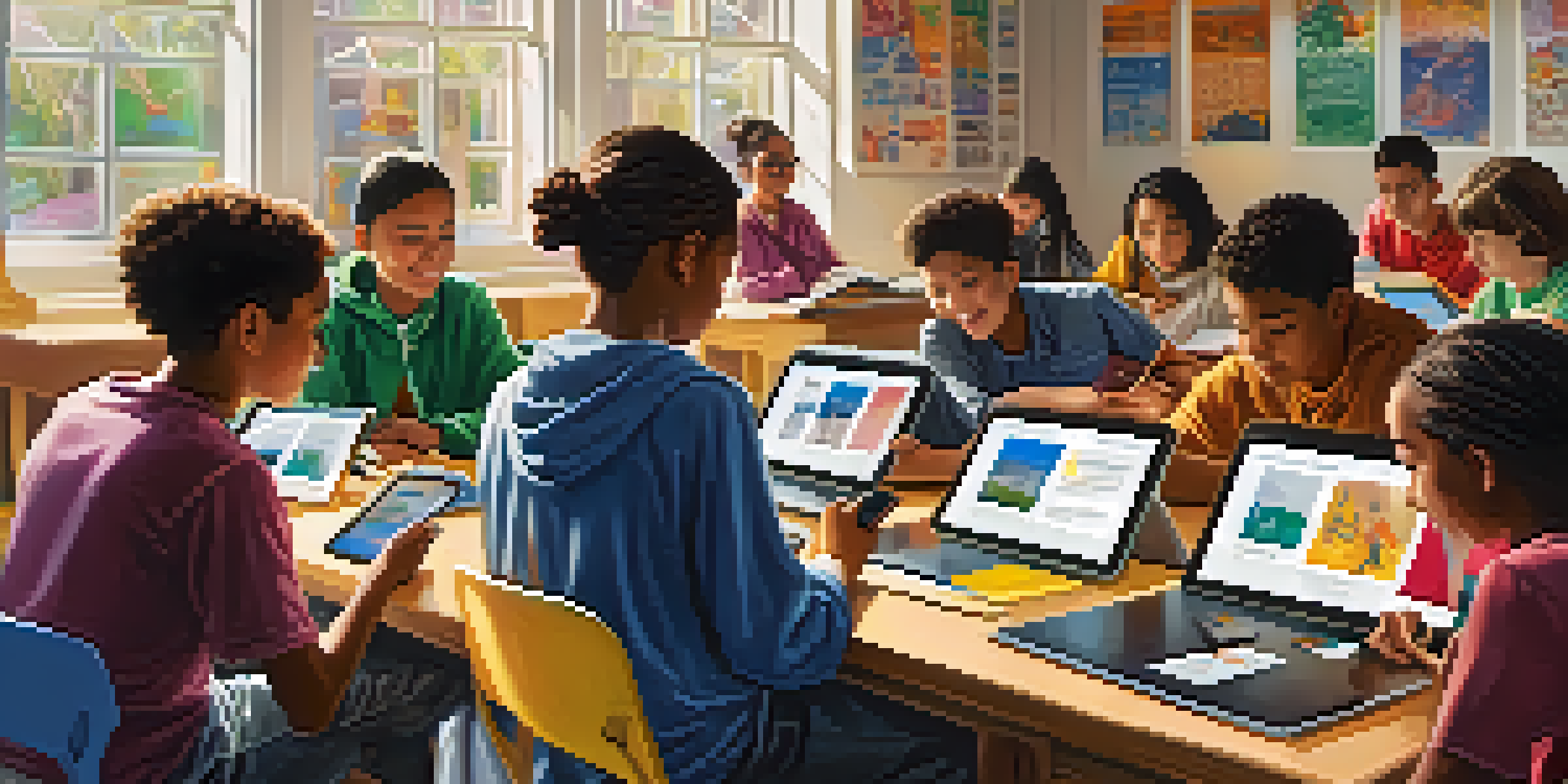The Impact of Mobile Learning on Cross-Cultural Communication

Understanding Mobile Learning and Its Relevance
Mobile learning, or m-learning, refers to educational experiences delivered via mobile devices. This approach allows learners to access content anytime and anywhere, making education more flexible and accessible. As our world becomes increasingly interconnected, the relevance of mobile learning is more pronounced, especially in diverse cultural contexts.
Education is the most powerful weapon which you can use to change the world.
With the rise of smartphones and tablets, learners can engage with educational content in real-time, breaking geographical barriers. This immediate access fosters a learning environment that is not only convenient but also responsive to the needs of individual learners. Thus, mobile learning becomes a powerful tool for promoting cross-cultural understanding.
Moreover, mobile learning applications often incorporate multimedia elements, such as videos and interactive activities, which can transcend language barriers. This makes it easier for learners from different backgrounds to grasp concepts and engage with content, ultimately enhancing their communication skills.
How Mobile Learning Promotes Cultural Awareness
One of the biggest advantages of mobile learning is its ability to expose learners to diverse cultures. By accessing global content, learners can understand cultural nuances, traditions, and perspectives that differ from their own. This exposure fosters empathy and respect for various ways of life.

For example, mobile learning platforms often include modules that focus on global issues, allowing learners to see how different cultures respond to similar challenges. Such comparative insights can spark meaningful discussions among learners, encouraging them to share their own cultural experiences and viewpoints.
Mobile Learning Enhances Accessibility
Mobile learning provides flexible access to educational content anytime, anywhere, fostering a more inclusive learning environment.
As learners engage with varied cultural content, they not only expand their knowledge base but also develop skills in cross-cultural communication. This is crucial in today’s globalized world, where effective communication across cultures can lead to better personal and professional relationships.
Enhancing Language Skills Through Mobile Learning
Mobile learning can significantly enhance language acquisition, which is a key component of cross-cultural communication. With language learning apps readily available, learners can practice speaking, listening, and writing in a new language at their own pace. This flexibility is particularly beneficial for those who may feel shy or anxious in traditional classroom settings.
Technology is best when it brings people together.
Moreover, many language learning platforms use gamification techniques to make learning enjoyable and engaging. By incorporating cultural references and real-life scenarios, these apps help learners understand not just the language, but also the cultural context in which it is used. This deeper understanding is essential for effective communication.
As learners improve their language skills, they become more confident in expressing themselves and understanding others. This confidence can lead to richer interactions with people from different backgrounds, reinforcing the importance of mobile learning in fostering cross-cultural dialogue.
Mobile Learning as a Tool for Global Collaboration
The collaborative nature of mobile learning encourages learners from different cultures to work together on projects. With tools like discussion forums and collaborative apps, learners can share ideas, resources, and feedback, creating a sense of community despite physical distances. This collaboration is vital for developing cross-cultural communication skills.
For instance, a group project involving students from various countries can lead to discussions about different cultural approaches to problem-solving. Such interactions not only enhance learning outcomes but also build lasting connections among participants, fostering a global network of learners.
Cultural Exposure Through Collaboration
Mobile learning encourages cross-cultural collaboration, allowing learners to share diverse perspectives and enhance their understanding of global issues.
Additionally, these collaborative experiences can challenge stereotypes and misconceptions, paving the way for deeper understanding and respect. As learners navigate these collaborative efforts, they are better equipped to communicate effectively in diverse environments, making mobile learning a key player in global education.
The Role of Technology in Bridging Cultural Gaps
Technology plays a pivotal role in mobile learning, serving as a bridge between cultures. With the ability to connect learners from different parts of the world, technology facilitates the exchange of ideas and perspectives. This exchange is crucial for expanding cultural horizons and fostering understanding.
For example, virtual reality (VR) and augmented reality (AR) experiences can immerse learners in different cultural contexts, offering firsthand exposure to diverse lifestyles. Such experiences can be transformative, allowing learners to engage with cultures in a meaningful way and promoting empathy.
Furthermore, as technology continues to advance, mobile learning platforms are becoming increasingly sophisticated, incorporating features that cater to diverse learning styles. This adaptability ensures that learners from various backgrounds can benefit from the educational content, reinforcing the idea that technology can indeed bridge cultural gaps.
Challenges of Mobile Learning in Cross-Cultural Contexts
While mobile learning offers numerous benefits, it also comes with challenges, particularly in cross-cultural contexts. Access to technology can be uneven across different regions, creating disparities in learning opportunities. Not all learners may have access to high-quality devices or stable internet connections, which can hinder their educational experience.
Additionally, cultural differences in communication styles can pose challenges when collaborating through mobile platforms. For instance, some cultures may prioritize indirect communication, while others favor directness. These differences can lead to misunderstandings if not navigated carefully, emphasizing the need for cultural sensitivity.
Technology Bridges Cultural Differences
Advancements in technology, such as VR and AI, facilitate cultural exchange and communication, helping to overcome barriers and promote empathy.
To overcome these challenges, educators and developers must prioritize inclusivity in mobile learning design. By considering the diverse needs of learners and providing support, we can create an equitable learning environment that embraces cross-cultural communication.
Future Trends in Mobile Learning and Cultural Communication
As we look to the future, the potential for mobile learning to enhance cross-cultural communication is immense. With ongoing advancements in technology, we can expect more innovative tools that facilitate cultural exchange and understanding. For example, AI-driven language translation apps can break down communication barriers, allowing learners to interact seamlessly.
Moreover, the rise of social media platforms tailored for learning can foster global communities where learners share their experiences and insights. This social aspect of mobile learning can promote collaborative learning and cultural exchange, enriching the overall educational experience.

In conclusion, the future of mobile learning holds exciting possibilities for cross-cultural communication. By embracing technology and fostering inclusivity, we can continue to break down barriers and promote understanding among diverse cultures, making our world a more connected place.